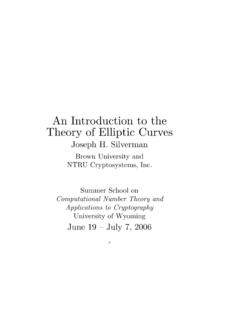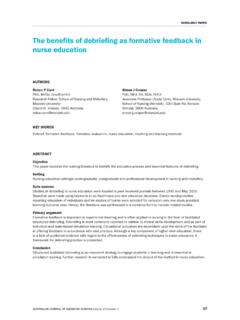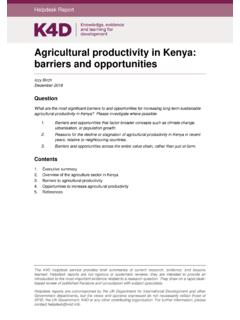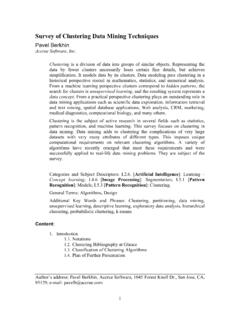Transcription of Scikit-Learn - Tutorialspoint
1 Scikit-Learn i Scikit-Learn About the Tutorial Scikit-Learn (Sklearn) is the most useful and robust library for machine learning in Python. It provides a selection of efficient tools for machine learning and statistical modeling including classification, regression, clustering and dimensionality reduction via a consistence interface in Python. This library, which is largely written in Python, is built upon NumPy, SciPy and Matplotlib. Audience This tutorial will be useful for graduates, postgraduates, and research students who either have an interest in this Machine Learning subject or have this subject as a part of their curriculum. The reader can be a beginner or an advanced learner. Prerequisites The reader must have basic knowledge about Machine Learning. He/she should also be aware about Python, NumPy, Scipy, Matplotlib. If you are new to any of these concepts, we recommend you take up tutorials concerning these topics, before you dig further into this tutorial.
2 Copyright & Disclaimer Copyright 2019 by Tutorials Point (I) Pvt. Ltd. All the content and graphics published in this e-book are the property of Tutorials Point (I). Pvt. Ltd. The user of this e-book is prohibited to reuse, retain, copy, distribute or republish any contents or a part of contents of this e-book in any manner without written consent of the publisher. We strive to update the contents of our website and tutorials as timely and as precisely as possible, however, the contents may contain inaccuracies or errors. Tutorials Point (I) Pvt. Ltd. provides no guarantee regarding the accuracy, timeliness or completeness of our website or its contents including this tutorial. If you discover any errors on our website or in this tutorial, please notify us at ii Scikit-Learn Table of Contents About the Tutorial .. ii Audience .. ii Prerequisites.
3 Ii Copyright & Disclaimer .. ii Table of Contents .. iii 1. Scikit-Learn Introduction .. 1. What is Scikit-Learn (Sklearn)? .. 1. Origin of Scikit-Learn .. 1. Community & 1. Prerequisites .. 2. Installation .. 2. Features .. 3. 2. Scikit-Learn Modelling Process .. 4. Dataset Loading .. 4. Splitting the dataset .. 6. Train the Model .. 7. Model Persistence .. 8. Preprocessing the Data .. 9. Binarisation .. 9. Mean 9. Scaling .. 10. Normalisation .. 11. 3. Scikit-Learn Data Representation .. 13. Data as table .. 13. Data as Feature Matrix .. 13. Data as Target array .. 14. iii Scikit-Learn 4. Scikit-Learn Estimator API .. 16. What is Estimator API? .. 16. Use of Estimator API .. 16. Guiding Principles .. 17. Steps in using Estimator API .. 18. Supervised Learning Example .. 18. Unsupervised Learning Example .. 23. 5. Scikit-Learn Conventions.
4 26. Purpose of Conventions .. 26. Various Conventions .. 26. 6. Scikit-Learn Linear Modeling .. 31. Linear Regression .. 32. Logistic Regression .. 34. Ridge Regression .. 37. Bayesian Ridge Regression .. 40. LASSO (Least Absolute Shrinkage and Selection Operator).. 43. Multi-task LASSO .. 45. 47. MultiTaskElasticNet .. 51. 7. Scikit-Learn Extended Linear Modeling .. 54. Introduction to Polynomial Features .. 54. Streamlining using Pipeline tools .. 55. 8. Scikit-Learn Stochastic Gradient Descent .. 57. SGD Classifier .. 57. SGD Regressor .. 61. Pros and Cons of SGD .. 63. 9. Scikit-Learn Support Vector Machines (SVMs) .. 64. Introduction .. 64. iv Scikit-Learn Classification of SVM .. 65. SVC .. 65. NuSVC .. 69. LinearSVC .. 70. Regression with SVM .. 71. 71. NuSVR .. 72. LinearSVR .. 73. 10. Scikit-Learn Anomaly Detection .. 75. Methods.
5 75. Sklearn algorithms for Outlier Detection .. 76. Fitting an elliptic envelop .. 76. Isolation Forest .. 78. Local Outlier Factor .. 80. One-Class 82. 11. Scikit-Learn K-Nearest Neighbors (KNN) .. 84. Types of algorithms .. 84. Choosing Nearest Neighbors Algorithm .. 85. 12. Scikit-Learn KNN 87. Unsupervised KNN Learning .. 87. Supervised KNN Learning .. 91. KNeighborsClassifier .. 91. RadiusNeighborsClassifier .. 97. Nearest Neighbor Regressor .. 99. KNeighborsRegressor .. 99. RadiusNeighborsRegressor .. 101. 13. Scikit-Learn Classification with Na ve Bayes .. 104. Gaussian Na ve Bayes .. 105. v Scikit-Learn Multinomial Na ve Bayes .. 107. Bernoulli Na ve Bayes .. 108. Complement Na ve 110. Building Na ve Bayes Classifier .. 112. 14. Scikit-Learn Decision Trees .. 114. Decision Tree 114. Classification with decision trees .. 115. Regression with decision trees.
6 118. 15. Scikit-Learn Randomized Decision Trees .. 120. Randomized Decision Tree algorithms .. 120. The Random Forest algorithm .. 120. Regression with Random Forest .. 122. Extra-Tree Methods .. 123. 16. Scikit-Learn Boosting Methods .. 126. AdaBoost .. 126. Gradient Tree Boosting .. 128. 17. Scikit-Learn Clustering Methods .. 131. KMeans .. 131. Affinity Propagation .. 131. Mean Shift .. 131. Spectral Clustering .. 131. Hierarchical 132. DBSCAN .. 132. OPTICS .. 132. BIRCH .. 132. Comparing Clustering Algorithms .. 133. 18. Scikit-Learn Clustering Performance Evaluation .. 137. Adjusted Rand 137. vi Scikit-Learn Mutual Information Based 137. Fowlkes-Mallows Score .. 138. Silhouette Coefficient .. 139. Contingency Matrix .. 140. 19. Scikit-Learn Dimensionality reduction using PCA .. 141. Exact PCA .. 141. Incremental PCA .. 142. Kernel PCA.
7 143. PCA using randomized SVD .. 143. vii 1. Scikit-Learn Introduction Scikit-Learn In this chapter, we will understand what is Scikit-Learn or Sklearn, origin of Scikit-Learn and some other related topics such as communities and contributors responsible for development and maintenance of Scikit-Learn , its prerequisites, installation and its features. What is Scikit-Learn (Sklearn)? Scikit-Learn (Sklearn) is the most useful and robust library for machine learning in Python. It provides a selection of efficient tools for machine learning and statistical modeling including classification, regression, clustering and dimensionality reduction via a consistence interface in Python. This library, which is largely written in Python, is built upon NumPy, SciPy and Matplotlib. Origin of Scikit-Learn It was originally called and was initially developed by David Cournapeau as a Google summer of code project in 2007.
8 Later, in 2010, Fabian Pedregosa, Gael Varoquaux, Alexandre Gramfort, and Vincent Michel, from FIRCA (French Institute for Research in Computer Science and Automation), took this project at another level and made the first public release ( beta) on 1st Feb. 2010. Let's have a look at its version history: May 2019: Scikit-Learn March 2019: Scikit-Learn December 2018: Scikit-Learn November 2018: Scikit-Learn September 2018: Scikit-Learn July 2018: Scikit-Learn July 2017: Scikit-Learn September 2016. Scikit-Learn November 2015. Scikit-Learn March 2015. Scikit-Learn July 2014. Scikit-Learn August 2013. Scikit-Learn Community & contributors Scikit-Learn is a community effort and anyone can contribute to it. This project is hosted on Following people are currently the core contributors to Sklearn's development and maintenance: 1. Scikit-Learn Joris Van den Bossche (Data Scientist).
9 Thomas J Fan (Software Developer). Alexandre Gramfort (Machine Learning Researcher). Olivier Grisel (Machine Learning Expert). Nicolas Hug (Associate Research Scientist). Andreas Mueller (Machine Learning Scientist). Hanmin Qin (Software Engineer). Adrin Jalali (Open Source Developer). Nelle Varoquaux (Data Science Researcher). Roman Yurchak (Data Scientist). Various organisations like , JP Morgan, Evernote, Inria, AWeber, Spotify and many more are using Sklearn. Prerequisites Before we start using Scikit-Learn latest release, we require the following: Python (>= ). NumPy (>= ). Scipy (>= ). Joblib (>= ). Matplotlib (>= ) is required for Sklearn plotting capabilities. Pandas (>= ) is required for some of the Scikit-Learn examples using data structure and analysis. Installation If you already installed NumPy and Scipy, following are the two easiest ways to install Scikit-Learn : Using pip Following command can be used to install Scikit-Learn via pip: pip install -U Scikit-Learn Using conda Following command can be used to install Scikit-Learn via conda: conda install Scikit-Learn On the other hand, if NumPy and Scipy is not yet installed on your Python workstation then, you can install them by using either pip or conda.
10 2. Scikit-Learn Another option to use Scikit-Learn is to use Python distributions like Canopy and Anaconda because they both ship the latest version of Scikit-Learn . Features Rather than focusing on loading, manipulating and summarising data, Scikit-Learn library is focused on modeling the data. Some of the most popular groups of models provided by Sklearn are as follows: Supervised Learning algorithms: Almost all the popular supervised learning algorithms, like Linear Regression, Support Vector Machine (SVM), Decision Tree etc., are the part of Scikit-Learn . Unsupervised Learning algorithms: On the other hand, it also has all the popular unsupervised learning algorithms from clustering, factor analysis, PCA (Principal Component Analysis) to unsupervised neural networks. Clustering: This model is used for grouping unlabeled data. Cross Validation: It is used to check the accuracy of supervised models on unseen data.

















